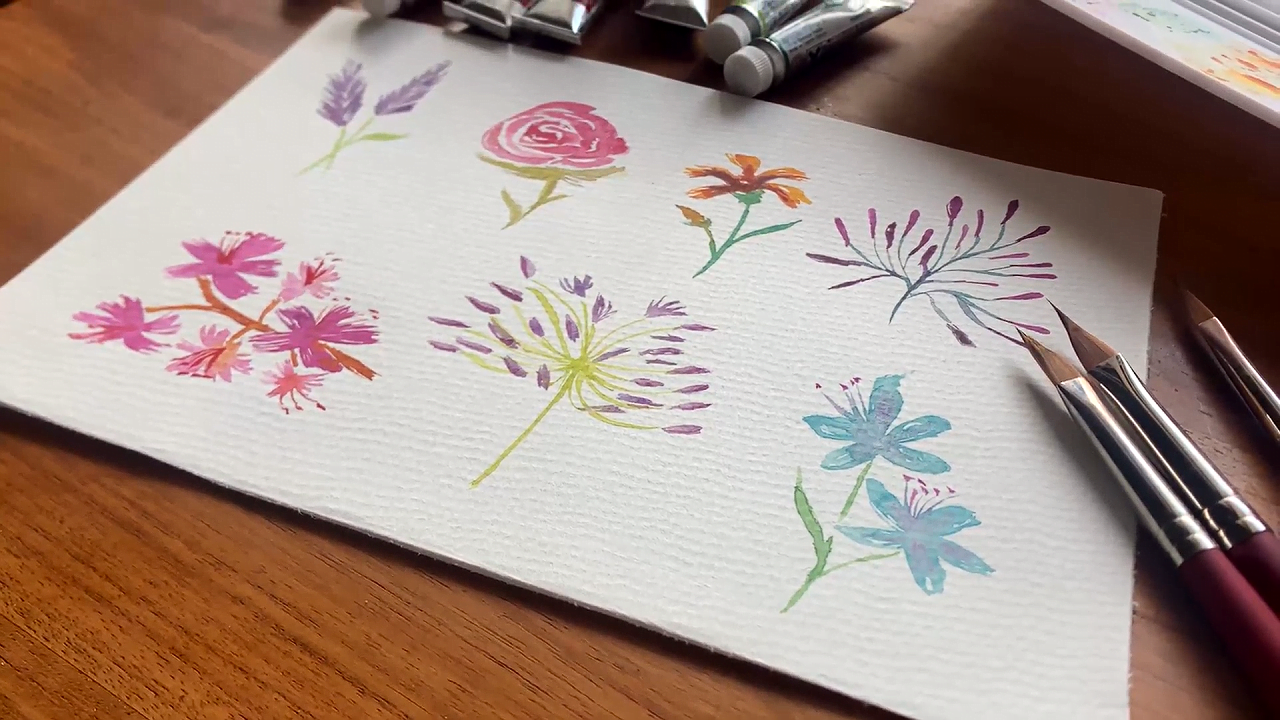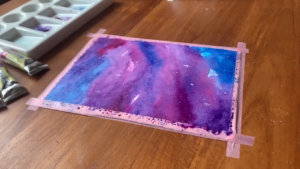Yes, acrylics can be beautifully used on watercolor paper with suitable materials and preparation. Prime the paper with gesso, thin down the acrylic paint with water, and you’re done! All else you need is a paintbrush and your artistic imagination to run wild.

Watercolor and acrylic paints are the basic art mediums used by every painter. Whether you are a beginner or a professional, everyone loves to use watercolor and acrylic paints to create beautiful paintings.
It is generally recommended that watercolor paints be used on watercolor papers for the best results. But have you ever wondered if you can use acrylic paints on watercolor papers? Well, if you have, the answer is yes!
I’m sure I have piqued your interest with this. Read ahead to find out exactly how to use acrylic paint on watercolor paper. And don’t forget to go through the tips for extra help.
Understanding Watercolor Paper

Watercolor paper is a special type of paper made especially for watercolor painting, having high water solubility. This is the painting paper that artists recommend whenever you’re making watercolor paintings. Generally, you will find two types of watercolor paper in the market: artist-grade and student-grade watercolor paper.
Artist-grade watercolor paper, also known as professional-grade watercolor paper, is made up of 100% cotton and is mostly acid-free paper, while student-grade paper is not. This is why the student-quality watercolor paper is cheaper than artist-quality paper.
What does watercolor paper weight mean?
Watercolor paper weight measures the weight of a sheet of watercolor paper. The higher the weight, the thicker the paper. The weight of watercolor paper is an important issue for artists because of a problem known as ‘buckling.’
Well, what’s that?
Buckling is the way paper warps when it is wet, which ruins the quality and look of your watercolor painting. Obviously, lightweight paper tends to buckle a lot more than heavy-weight paper.
Therefore, lightweight paper requires ‘stretching’ before you do watery painting on it, but that is a time-consuming process. So, you can just get a heavier-weight paper. But heavy-weight paper, on the other hand, is more expensive.
Traditionally, watercolor paper weights are expressed in the British Imperial units: pounds per ream. A ream consists of 500 sheets, while the size of each sheet in a ream is referred to as the ‘basis size.’
In watercolor papers, the basis size of a sheet is 22 x 30 inches and is known as the full imperial sheet. Additionally, whenever you see the weight printed on the label of the watercolor paper, it is actually describing the weight of 1 ream of full imperial sheets.
Watercolor Paper GSM
To overcome the problems of different units being used by different manufacturers, GSM is now more popularly used. GSM stands for grams per square meter. This measures the weight of a single sheet of an area of precisely 1 m2. For example, 300 gsm paper has a paper weight of about 140 lbs. Actually, this is the best weight to get for watercolor papers.
Types Of Watercolor Paper
Watercolor paper is available in three forms: watercolor sheet, watercolor roll, and watercolor block. Rolls are generally available in 44-inch x 10-yard size, while watercolor sheets are available in the traditional full imperial size. Watercolor blocks, on the other hand, are pre-cut watercolor sheets that are glued on all sides.
Textures Of Watercolor Paper
Watercolor paper can be available in two different textures: hot-pressed and cold-pressed. Cold-pressed watercolor paper has a smooth surface and works well with all painting consistencies. On the other hand, hot-pressed paper is more on the rough side and best suited for paint lifting and corrections.
Obviously, there is no set standard for the texture of watercolor paper. One brand’s hot-pressed paper might be different from another brand. So, experimenting is the key.
What Is The Difference Between Watercolor And Acrylic Paper?
Acrylic paper is thicker and more durable than watercolor paper and is obviously more suited to acrylic painting. It can either be absolutely flat or be embossed with a canvas-like pattern. Another difference is the colors of the two. Acrylic paper mostly tends to have an off-white color, while watercolor paper is mostly available in white or cream color.
Watercolor paper is, however, more absorbent than any acrylic artist paper. So, it is more suited for paint mediums that use a lot of water. This also affects the drying time of the paint and the possibility of buckling or warping.
Additionally, watercolor paper is made entirely out of cotton fiber. This prevents watercolor paper from yellowing and makes it suitable for various painting techniques. Acrylic paper, on the other hand, is made from cellulose and synthetic fiber. Hence, it is not susceptible to warping or buckling.
Lastly, acrylic paper tends to be cheaper than watercolor paper.
Acrylic Paints: What You Need To Know
Acrylic paint is made out of a combination of water, acrylic resin, binder, and pigment. It is described as having the combined qualities of both watercolors and oil painting. Acrylic paint is also permanent on paper, meaning there is no easy way to remove it once you paint on it. Although, you could try removing it with a solvent or a specific eraser.
Note that acrylic paint is not permanent on other non-porous surfaces like glass or metal.
Pros And Cons Of Using Acrylic Paint
The popularity of acrylic paints resides in the fact that their drying time is so quick. The paint is very elastic and flexible, so it expands and contracts with the temperature changes without developing any cracks.
Acrylic paint is also highly lightfast, meaning its colors remain vibrant for a very long time and don’t fade with time. Unlike watercolors, acrylic paint can be used on many different surfaces, like watercolor paper, acrylic paper, etc. They also have a high opacity level.
However, due to their permanence and quick drying time, you cannot reuse acrylic paints after drying. The colors darken as the paint dries, which might change the overall look of your acrylic painting, known as a color shift.
Types Of Acrylic Paint
Acrylic paint is available in varying consistencies and thicknesses. You can even buy chemicals to alter the texture and consistency of your acrylic paint. Here are a few types of acrylic paint:
- Thick-Bodied- Also known as professional-grade acrylic paint, this paint has a thick consistency and is loaded with color pigment. It is the best for texture and shows the most color shift.
- Student-Grade- This is more suitable for beginners and is cheaper than professional-grade paint. It has lesser color pigment and color shift.
- Soft-Bodied- Has a fluid-like consistency and is best for drip and splatter techniques, providing good coverage.
- Acrylic Inks- It has ink-like consistency and is loaded with color pigment. This is a good option for using as watercolor paint.
What Is The Best Surface To Use For Acrylic Paint?
The best surface to use acrylic paint on is any non-porous surface, like glass, plastic, or metal. This can also be a special type of paper designed explicitly for acrylic paint. The paint prefers non-porous surfaces since they have low absorbency. This means the paint won’t dry too fast, giving you time to work with it.
Why Do Some Artists Prefer To Use Watercolor Paper For Acrylic Painting?
Many artists prefer to use acrylic paint because of its convenience, quick drying time, and vibrant colors. You mostly need to apply a thin layer of primer on the painting surface before you begin painting.
If you use watercolor paper, you can easily skip the priming stage. Just add water to the acrylic medium until it reaches your desired consistency. Additionally, you can also use the watercolor paper as practice drawing paper.

Choosing Watercolor Paper For Acrylic Paint
When choosing suitable watercolor paper for acrylic paint, you should keep in mind the thickness, size, and painting technique you are going to use. Some people prefer to use watercolor sheets, which can be found in packs in the market. Another good option is a sketchbook.
A less popular option is a watercolor paper block. They are glued on all four sides, unlike a watercolor paper pad. This makes the paper block more durable and resistant to warping than a paper pad.
Well, now that we have talked about both acrylic paint and watercolor paper, it is now time to combine the two.
Using Acrylic Paint On Watercolor Paper
Art Materials Needed
- Acrylic paint
- Watercolor paper
- Painting palette
- Gesso
- Jar of water
- Paintbrush
- Rag or paper towels
- Watercolor boards
Techniques That Can Help Acrylic Paint Stick To Watercolor Paper
- Soak the paper in water- Soaking the paper in water for a few minutes will help soften the cotton fibers and make the paper more pliable.
- Paper stretching- Stretch the paper by taping it down to a painting board. This helps in preventing warping or buckling.
- Allow the paper to dry- After the paper soaking and stretching are done, allow the paper to dry completely before you start making your beautiful illustration.
- Apply a fixative or sealant- Apply a fixative or sealant after the painting is finished to seal the colors in place.
Prepare Your Paper Surface For Acrylic Painting By Applying Gesso
Pour a generous amount of gesso into a clean jar and stir it for a few minutes. After stirring, apply a thin layer of gesso on both sides of the paper. This will help prevent the paper from warping or buckling and ensure a successful painting project.
This step is optional since you don’t have to worry about warping or buckling if you are just practicing acrylic paintings.
Steps For Acrylic Painting On Watercolor Paper
- After the gesso dries, place your paper on the painting board. Fix it in place by using a few pieces of masking tape.
- Now, you can just start painting! Yes, it is that easy.
- After your painting has dried, seal the finished painting with a water-based sealant. Let that dry for half an hour at least.
Tips For Acrylic Painting On Watercolor Paper
1. Watercolor Paper Weight
Watercolor paper is sold in many different weights and GSMs. But for acrylic painting, you should keep in mind that heavier-weight papers are better. The heavier the paper, the sturdier it is. So, 140 lbs. or 300 GSM is the best watercolor paper.
2. Preventing buckling
Buckling can be prevented by using heavy watercolor paper. However, if some buckling still occurs, here is how you can prevent it. Lay the buckled painting paint-side down on a clean and flat surface. Lightly mist the back of the painting with distilled water and cover it with a paper towel or a single sheet of wax paper. Weight the entire thing down with heavy items and leave it overnight.
3. Testing On Cheap Paper
Consider your money costs when using acrylic paint to paint on watercolor paper. Decent watercolor paper can actually cost more than acrylic paper. So, test your painting technique on cheap paper, like pastel or waxed paper, before using it on good quality watercolor paper.
4. Absorbency
Watercolor paper is highly absorbent since it is made to absorb water-soluble watercolor paints. Acrylic paint, on the other hand, might dry out too quickly. So, mix acrylic paint with some water or use a slow-drying medium to delay the drying.
5. Diluting The Paint
The trick to using acrylic paint on watercolor paper is to dilute the acrylic paint. This way, you won’t have to prime your painting surface with gesso. Just thin down the consistency of the acrylic paint to the level you desire, and you’re done!
6. Paper Longevity
Place your finished acrylic paintings in a glass frame to protect them from UV radiation. Also, try to keep the painting away from direct sunlight. All this will help promote the longevity of the paper and the painting.
No, there is no necessity. You can do it to prevent the warping, curling, or buckling of the paper. Just thin the consistency of the acrylic paint before using it. This way, there will be no need to prime the paper with gesso. The advantage of using acrylic paints is that they work on many different painting surfaces, like acrylic paper, cartridge paper, watercolor paper, canvas paper, textiles, mixed media paper, etc. Each paper has its own unique set of properties that will result in a different painting. So, experiment and find out which one works the best for you. Obviously, acrylic paper is specifically designed for acrylic paints. So, acrylic paper is the ideal option for acrylic painting. Yes, you definitely can. You can either mix the watercolor paint and acrylic paint together on a palette before you start painting on watercolor or acrylic paper. You can also paint with the two painting mediums on top of each other. Just make sure the acrylic paint is dry before you add watercolor paint on top. In the same way, ensure to prime the paper with gesso before painting. Yes, you can use acrylic paint on mixed-media paper. It will definitely add unique textures and blends to your work. However, keep in mind that mixed media paper is thinner than canvas paper, so use a light hand when painting. Although acrylic paint can be used as watercolor paint, there are a few things you need to keep in mind: All you require is some water to turn your acrylic paint into watercolor. Start by adding small amounts of water to your acrylic paint to dilute the paint. Keep adding water till you reach the desired consistency. Here are a few differences between the two most commonly used paint mediums: There are many different types of painting papers available for you to choose from. Cotton paper is the most popular and most suitable for watercolor painting. Wood pulp or synthetic paper, on the other hand, is more suitable for oil paints and acrylics.Watercolor Paper With Acrylics FAQs

The Bottom Line
Hopefully, this helped you gain some insight into how to use acrylic paint to paint on watercolor paper. As you might have realized, it is easier than you might have thought. All you need are some good quality acrylics, good watercolor paper, a paintbrush, and your artistic skills.
Essentially, you should take full advantage of the versatility of acrylic paint. It can be used on so many different surfaces, so why not use it on watercolor paper? With the proper preparation and the right techniques, you can achieve exciting and beautiful results on watercolor paper.
Well, that’s all from my side. If you have any tips or recommendations you would like to give to an interested artist, feel free to share!
And have fun experimenting!
